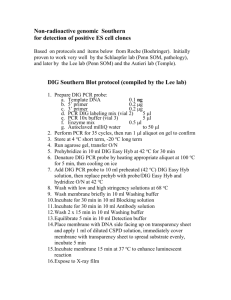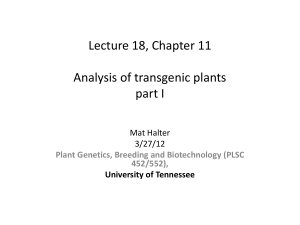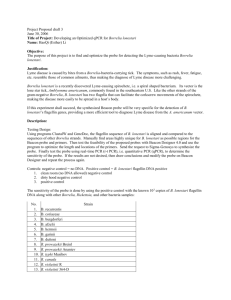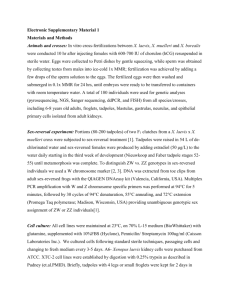Dr. Escobar
advertisement
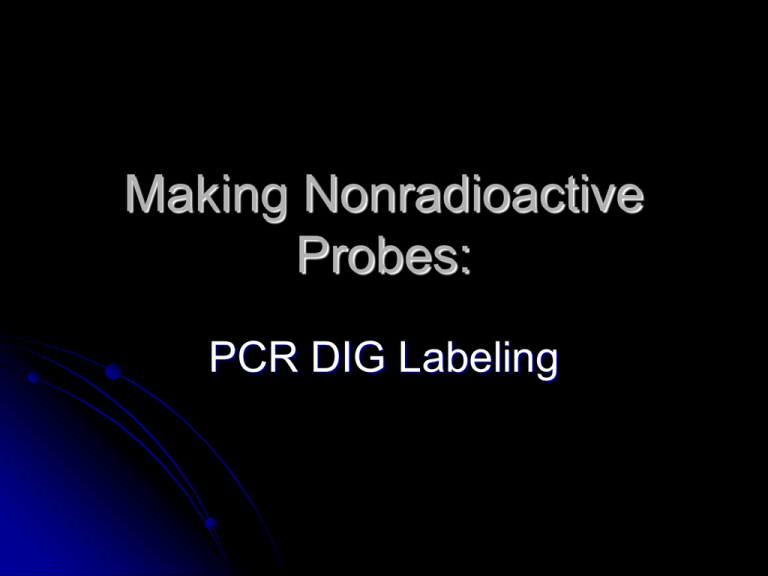
Making Nonradioactive Probes: PCR DIG Labeling Broad and Long Term Objective To determine the copy number of Myb transcription factor genes in the genome of the model plant Arabidopsis thaliana Research Plan Isolate Genomic DNA Southern Blot Digest Genomic DNA with Various Restriction Enzymes Agarose Gel Electrophoresis and Southern Transfer Make Non-Radioactive Myb Probe Hyribidize Probe to Southern Blot Washes and Colorimetric Detection Data Analysis Today’s Laboratory Objectives To make a homologous gene probe to the Myb61 gene of Arabidopsis To learn how to set up and run a polymerase chain reaction (PCR) Evaluate PCR products and the success of the reaction Nucleic Acid Probes Definition: Short (< 2000 bp), single stranded DNA or RNA molecule that is used to identify a particular nucleic acid sequence through hybridization Probe labeling: Primary label- radioactive or fluorescent nucleotides Secondary label- hapten-bound nucleotides Probe Classification: Heterologous- from a different organism Homologous- from the same organism Probes and DNA blots • Size-separated genomic DNA fragments (single stranded) are covalently bound to the surface of a nylon membrane • Membrane is mixed with a solution of single stranded Myb61 probe (labeled with digoxigenin), allowing hybridization of the probe to complementary DNA sequences • Membrane is washed to remove unbound probe molecules and and colorimetric detection is performed to visualize the Myb-homolgous DNA fragments Why label nucleic acids with DIG? DIGoxigenin is a steroid found exclusively in Digitalis lanata and D. purpurea DIG can be coupled to nucleotide triphosphates (e.g. DIG-dUTP) DIG-dUTP can be incorporated into DNA or RNA by DNA/RNA polymerase Antibodies can be raised against DIG in sheep or rabbits. These antibodies will bind to DIG-labeled nucleic acid probes How is our probe synthesized? Polymerase Chain Reaction (PCR) http://pathology2.jhu.edu/molec/techniques_main.cfm## DIG DNA Labeling by PCR Reaction Components: - Template DNA - Primers - DIG dNTP mix = 2mM dATP/dGTP/dCTP, 1.3 mM dTTP, 0.7 mM DIG-dUTP) - Buffer - dH2O - Taq DNA Polymerase PCR Template DNA: Myb61 in pENTR221 Myb61 cDNA Template = 1.5 Kb M13 Reverse GGAAACAGCTATGACCATG M13 Forward GTAAAACGACGGCCAGTG How does one judge the success of a PCR reaction? Agarose gel electrophoresis is used to size PCR products*. Is a product band visible? Are there multiple bands? Is the band of the expected size? Detection of bound probe Blot incubated with DIG probe Wash to eliminate unbound probe molecules Blot incubated with anti-DIG antibody coupled to an alkaline phosphatase enzyme At sites on the blot where the DIG probe has hybridized, the antibody binds to the DIG. The phosphatase reacts with uncolored substrates (NBT/BCIP) to produce a localized blue-colored precipitate Detection of bound probe, ctd. Uncolored substrates BCIP and NBT BCIP and NBT are dephosphorylated by alkaline phosphatase, forming insoluble blue-colored products Blot incubated at 37° C for color development Faster and safer than radioactive labeling, almost as sensitive Next Week Hybridization Washes and Color Detection Analysis

